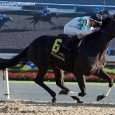By Noel Michaels
The new season at Belmont Park has arrived. The 2020 spring/summer meet opens June 3 (Wednesday), and runs through July 12. In many ways, the shortened 25-race-day meet will look a lot like Saratoga in terms of quality and duration.

Belmont Park – Photo Courtesy of NYRA
The season will be only six weeks and there’s a stakes race nearly every day, with a first post at 1:15 p.m. Racing will be conducted Thursdays through Sundays, except for opening week. No spectators will be in attendance.
The biggest day, of course, will be the 152nd running of the Belmont Stakes on June 20. The third leg of racing’s Triple Crown this year will be after the series was rescheduled due to the coronavirus pandemic. The distance of the Belmont Stakes will be shortened to 1 1/8 miles, and the race is expected to attract a strong cast led by Florida Derby winner Tiz the Law, trained by Barclay Tagg.
New York’s top riders are back in town, too. For handicappers, that means Jose Ortiz and Irad Ortiz, Jr., are likely to lead the way over a star-studded group that includes Hall of Famers Javier Castellano and John Velazquez, as well as Joel Rosario, Manny Franco, Jose Lezcano, and Luis Saez. These riders should be in the top 10 in the jockey standings during the season, along with perhaps Kendrick Carmouche and Dylan Davis.
Trainers Linda Rice, Rudy Rodriguez, and Jeremiah Englehart should join Todd Pletcher and Chad Brown atop the trainer standings.
An in-depth look at the Belmont Park 2020 jockey and trainer picture is in the works for next week so stay tuned.
Belmont Track Handicapping Profile
On the dirt track, speed is a handy commodity. Other tracks such as Monmouth and Pimlico have more of a reputation as being speed-biased tracks, but Belmont Park can be right up there with the best of them.
In addition to running styles, you should also pay attention to the best paths on the main track because the inside part of the track has not been the best at recent meets and jockeys tend to avoid inside trips on the main track. Let’s see if this trend continues this season.
When it comes to post position angles on the main track, remember that Belmont runs almost no two-turn races due to its 1 1/2-mile circumference. This nearly negates any inside bias the track might have in route races, which are all one-turn affairs up to 1 1/8 miles (another factor that minimizes any possible advantage to being inside on the dirt).
One-turn specialists rule, and when handicapping Belmont races from one-mile to 1 1/8-miles, you always want to scan horse’s past performances to find runners with tactical speed who win races around one turn.
On the turf courses, both the inner turf and the outer turf tracks are big, wide, and fair with long stretch runs. Outside turf posts are a concern, however, at distances between one mile and 1 1/8 miles.
Horses breaking from the far outside in one-mile races and 1 1/16-mile races can be most negatively affected by outside posts. At one mile and 1 1/16-miles on the Widener turf course at the spring/summer meet, posts 8-12 should each win for about a combined 5-6 percent.
On the inner turf course at 1 1/16-miles, horses from posts 8-10 each can be expected to win only about 5 percent at a time. At 1 1/8-miles, posts 8-11 may win only about 7 percent. When in doubt, give favoritism in turf routes to horses breaking from posts 1-7 or 1-8.
In the popular and prominent turf sprint department, Belmont runs tons of races at both 6 furlongs and 7 furlongs (one turn). Rice does particularly well in Belmont turf sprints, as does Christophe Clement.
Logic would dictate that inside posts would be preferential in turf sprints, however, not only aren’t inside posts better in Belmont’s turf sprints, but, in fact, the opposite is true. Outside posts are the best post positions in Belmont turf sprints, and inside posts are the worst.
The anti-rail bias is particularly prevalent in Belmont turf sprints on the Widener course, where the rail Post 1 customarily wins at only 4-5 percent at both 6- and 7 furlongs. Actually, posts 1-3 are all disadvantages in Belmont turf sprints in big fields based on long-term win percentages. In fields of eight horses or less, the post position bias diminishes or disappears.
Enjoy the annual renaissance of New York racing with the return to beautiful Belmont Park. The 2020 meet will be a season like no other. Best of luck!
If you enjoyed this piece, check out other articles at our horse racing news section!



